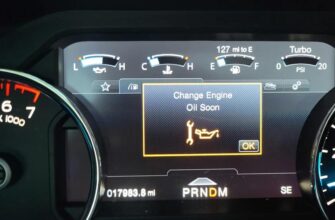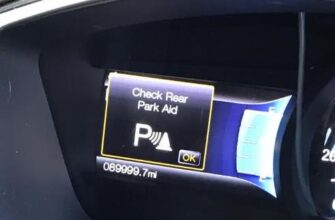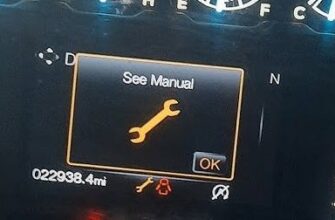There’s the familiar rumble of your Ford F-150 engine, that satisfying push as you accelerate… and then there’s an extra sound you don’t recognize. A whine. A whirring sound that gets louder or changes pitch as you press the gas pedal. If your F-150 is making a whining noise when accelerating, it’s natural to wonder what’s causing it and if it’s a sign of a serious problem.
Trucks, with their robust engines and drivetrains, can sometimes develop unique sounds. A whining noise under acceleration can come from various systems, from simple belt-driven accessories to more complex internal components. Pinpointing the source is the first step to getting your truck running smoothly and quietly again.
Let’s break down the common culprits behind that F-150 acceleration whine and how you can start diagnosing the issue.
Target Audience: This guide is for owners of Ford F-150 trucks who are hearing an unusual whining or whirring noise that occurs or changes in pitch/volume specifically during acceleration. It’s aimed at providing practical troubleshooting steps for DIYers and informing owners about potential issues before consulting a professional mechanic.

Understanding Car Noises: What a Whine Might Mean
Your truck makes various sounds during normal operation, but new or changing noises are like clues the vehicle is giving you. A “whine” or “whirring” sound is distinct from grinding (metal-on-metal), knocking (internal engine issue), or squealing (often belts).
Speed vs. RPM
When diagnosing a whine, try to notice if the sound changes with:
- Engine RPM: Does the pitch or volume change as the engine revs higher, even if the road speed is constant (like in Park or Neutral)? This often points to something driven by the serpentine belt (accessories).
- Vehicle Speed: Does the pitch or volume change as the truck moves faster, regardless of what gear the engine is in? This usually points to drivetrain components (transmission, differential).
- Both: Some issues can be influenced by both.
The fact that your whine happens specifically “when accelerating” suggests it’s related to components working harder under load, but pinning down how it changes is key.
Common Reasons for a Whining Noise When Accelerating in Your Ford F-150
Ford F-150s are equipped with various engines and transmissions across their generations, but certain components are common sources of whining noises under acceleration load.
1. Accessory System Issues (Often RPM-Dependent Whine)
These are components powered by the serpentine belt, and their internal bearings can wear out.
- Power Steering Pump: This is a classic source of whining, often noticeable at lower speeds or when turning the steering wheel. However, a failing pump can whine at higher RPMs too, potentially increasing with acceleration. Low power steering fluid can also cause a pump to whine.
- Failing Alternator: The alternator charges your truck’s battery. As its internal bearings wear, they can produce a whining or grinding sound that changes directly with engine RPM.
- AC Compressor (When Engaged): If you only hear the whine when your air conditioning is on, the AC compressor’s internal bearings might be failing. The noise will change with engine RPM.
- Idler or Tensioner Pulleys: These small pulleys guide and tension the serpentine belt. Their bearings can wear out over time, creating a persistent whine that follows engine RPM.
2. Belt Issues (Can Cause Whining or Squealing)
A simple belt problem can sometimes sound like a whine.
- Loose or Worn Serpentine Belt: A worn, glazed, or improperly tensioned serpentine belt can slip slightly, creating a squealing sound, but sometimes it can manifest as a high-pitched whine that changes with RPM.
3. Air Induction / Turbo Issues (Distinct Whine, Especially in EcoBoost)
F-150’s EcoBoost engines are turbocharged, adding complexity and potential noise sources.
- Turbocharger Bearings: Turbochargers spin at extremely high speeds. A failing turbo bearing can produce a very distinct, often high-pitched, mechanical whine that is most noticeable when the turbo is spooling up under acceleration (i.e., when you’re asking for boost). A certain amount of turbo noise is normal for EcoBoost engines, but a new or louder whine is a concern.
- Air Intake or Boost Leaks: Leaks in the air intake system before the turbo or in the boost tubes/intercooler system after the turbo can cause a whistling or whining sound as air is sucked in or boost pressure escapes. These leaks often also lead to power loss, a topic covered in guides like Why Is My VW Polo Losing Power When Accelerating (though on a different vehicle, the principle of intake/boost leaks causing noise and power loss is similar).
4. Drivetrain Component Noises (Often Speed-Dependent Whine)
These sounds usually change with how fast the wheels are turning, rather than just how fast the engine is spinning.
- Transmission / Torque Converter: Internal wear, low fluid, or fluid issues in the transmission or torque converter can create whining or whirring noises. These sounds are often most apparent in specific gears or at certain road speeds and change as the transmission shifts.
- Differential / Rear Axle: The differential (in the rear axle, or front if 4WD) transfers power to the wheels. Worn gears, bearings, or low/improper fluid in the differential can cause a whine that changes with vehicle speed, particularly noticeable under acceleration load as the gears are stressed.
“Had a whining noise on my F-150, thought it was the transmission. Mechanic listened and traced it to a failing idler pulley on the belt system. Simple fix, thankfully!” – John D., F-150 Owner
Pinpointing the Source: How to Diagnose the Whine
Diagnosing a specific noise can be tricky, but a systematic approach helps.
1. Listen Very Carefully
- When does it happen? ONLY when accelerating? Does it start/stop at a specific RPM or speed? Is it there cruising at speed? Is it there revving the engine in Park/Neutral?
- Where does it seem to come from? Front? Rear? Driver’s side? Passenger’s side?
- How does the pitch/volume change? Does it get higher pitch with RPM? Higher pitch with speed?
2. Check Fluid Levels
Check the fluid levels for your power steering, transmission, and differential (front and rear if 4WD). Low fluid can cause components to whine. Note the condition of the fluid too (color, smell).
3. Visual Inspection of Belts and Pulleys
With the engine off and cool, inspect the serpentine belt for cracks, glazing, or damage. Check all the pulleys it wraps around (alternator, AC compressor, power steering pump, idler pulleys, tensioner). Try spinning the pulleys by hand (engine off!) to feel for roughness or listen for noise from the bearings.
4. Use a Stethoscope (Carefully!)
An automotive stethoscope can be invaluable for isolating noises. Be extremely careful around moving engine parts. With the engine running (and the noise occurring), carefully touch the probe end of the stethoscope to non-moving parts of accessories (like the housing of the alternator or power steering pump near the bearing) or pulley bolts to listen for where the sound is loudest.
5. Check for Warning Lights
Is your Check Engine Light or a Wrench Light on? These lights indicate the computer has detected an issue, which could be related to the source of the noise. A Wrench Light on a Ford often indicates a powertrain fault that might lead to limp mode. Our guide on How to Get Your Car Out of Limp Mode touches on powertrain issues that can restrict performance.
“My F-150’s whine changed perfectly with road speed, not RPM. Knew it had to be the differential or transmission. Mechanic confirmed it was the rear differential needing a fluid flush and additive.” – Sarah K., Pinpointed Drivetrain
When to Seek Professional Help
While basic checks can rule out simple things, many of the potential sources of a whining noise, especially those involving internal drivetrain components or turbochargers, require professional diagnosis and repair.
- If the noise is sudden, very loud, or rapidly getting worse.
- If the noise is accompanied by other symptoms like power loss, strange smells, fluid leaks, or warning lights.
- If you cannot safely or confidently identify the source of the noise yourself.
- If you suspect issues with the transmission, differential, internal engine, or turbocharger.
A qualified mechanic has lifts to safely inspect the underside of the truck, specialized listening tools, diagnostic equipment to check for internal transmission/drivetrain faults, and the expertise to accurately diagnose the specific cause of the whine.
For more detailed F-150 specific troubleshooting, diagrams of belt routing, or discussions about common noises for your particular model year, consult your Ford F-150 Owner’s Manual, a relevant service manual (like Haynes or Chilton), or dedicated online Ford F-150 owner forums. (Mentioning types of external resources).
Frequently Asked Questions (FAQ)
Q: Is a slight whining noise normal for a Ford F-150?
A: A very faint whine from the power steering pump at low speeds or a subtle turbo spooling sound on EcoBoost models under acceleration might be considered normal characteristics by some. However, a new, loud, or changing whine that wasn’t there before is usually an indication of an issue that needs investigation.
Q: Does a whining noise always mean my transmission is failing?
A: No, not always. While the transmission or torque converter can cause whining noises, it’s just one possibility. Many other components like power steering pumps, alternators, idler pulleys, or the differential can also produce a whine. Proper diagnosis is needed.
Q: Can low fluid cause a whining noise in my F-150?
A: Yes, low fluid levels are a common cause of whining, particularly in the power steering system. Low fluid in the transmission or differential could also potentially contribute to noise and indicate a more serious problem.
Q: What’s the difference between an RPM-dependent whine and a speed-dependent whine?
A: An RPM-dependent whine gets louder or changes pitch as the engine revolutions (RPM) increase, regardless of how fast the truck is moving (e.g., revving in neutral). This usually points to engine-driven accessories or something belt-related. A speed-dependent whine gets louder or changes pitch as the truck goes faster, regardless of the engine RPM (e.g., constant whine at 40 mph whether you’re in 4th or 5th gear). This usually points to drivetrain components like the transmission or differential.
Q: If my F-150 has an EcoBoost engine, is the turbo whine normal?
A: EcoBoost turbos often have a noticeable whine, especially under load as boost builds. A new, sudden, excessively loud, or changing whine, however, could indicate an issue with the turbo itself or a boost leak.
Conclusion
A whining noise when your Ford F-150 is accelerating is a clue that one of its many mechanical components is experiencing wear or a problem. Common sources range from accessible parts like pulleys and belts or the power steering pump, to more complex systems like the turbocharger, transmission, or differential. Carefully observing when and how the noise occurs, checking fluid levels, and performing a visual inspection can help you start to pinpoint the issue. However, due to the variety of potential causes and the complexity of truck systems, professional diagnosis is often necessary to accurately identify the source of the whine and ensure the correct repair is made, keeping your F-150 running strong and quiet.








